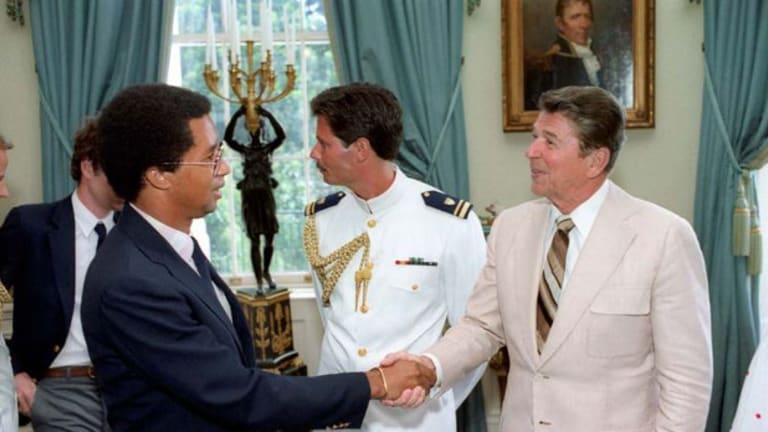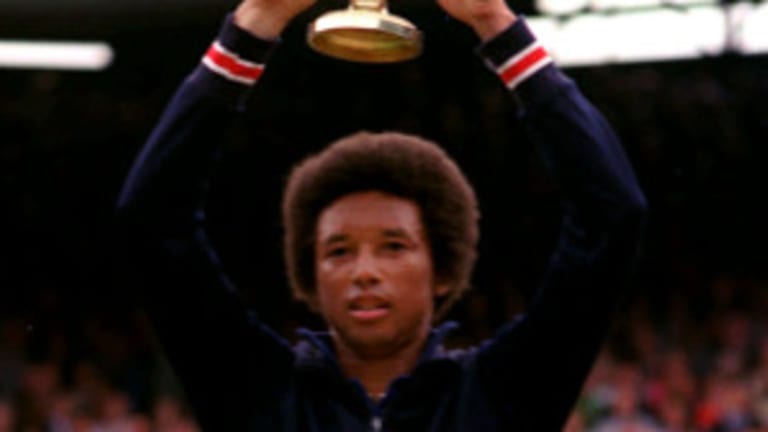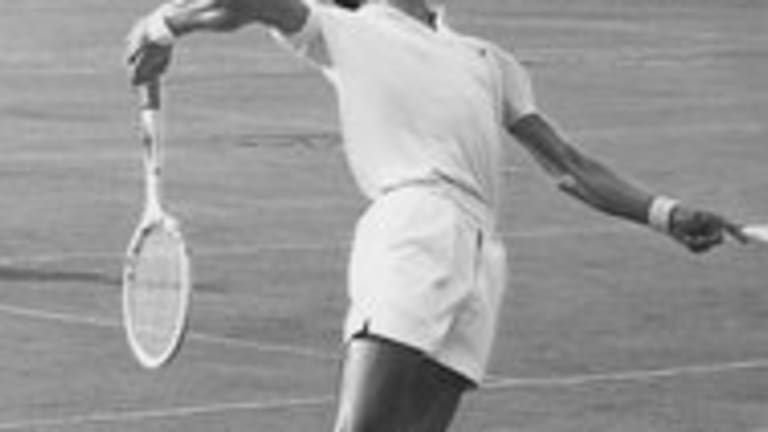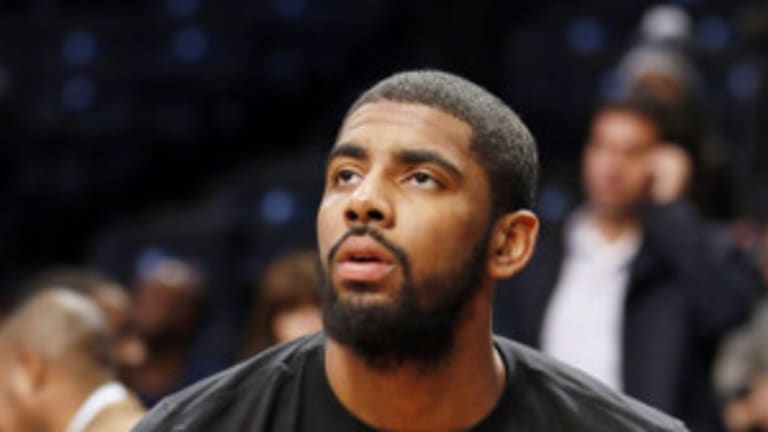Last week I posted my 2014 gift guide for the tennis reader in your life. Perhaps the most significant of those books, from the standpoint of public life in the U.S. today, was Eric Allen Hall's Arthur Ashe: Tennis and Justice in the Civil Rights Era. This year black athletes have played a more active role in politics than at any time in the last three decades; with that in mind, Hall's look at tennis's most famous African-American activist becomes a more timely and important read. Here's a Q&A with the author from his office at Georgia Southern University.
Role Model
By Steve Tignor Dec 19, 2014Federer Turns 40
The Rally: 20-plus years in the making, how writing The Master humanized Federer for its author
By Steve Tignor Aug 08, 2021Roland Garros
The Rally: Is Novak Djokovic's Roland Garros triumph the most remarkable of his 19 Slam-title runs?
By Joel Drucker and Steve Tignor Jun 13, 2021The Rally: Sliding into the clay swing as Roland Garros looms
By Joel Drucker and Steve Tignor May 10, 2021The Rally: How notable is Novak Djokovic's new No. 1 ranking record?
Mar 09, 2021The Rally: A Wild Idea
By Steve Tignor Sep 03, 2015The Rally: Off-Season? What Off-Season?
By Steve Tignor Dec 18, 2014The Rally: Back on the Bus
By Steve Tignor Jul 23, 2014The Rally: Transition Time
By Steve Tignor Jun 11, 2014Quatre: The Roland Garros Rally
By Steve Tignor May 22, 2014Role Model
What would Arthur Ashe have made of Ferguson? A talk with his mos
Published Dec 19, 2014
Advertising
I’ll start by asking what made you interested in writing this book. You’re a professor of African-American Studies, so you obviously have an interest in the Civil Rights side of the story. But why Ashe?
I grew up in a racially and socioeconomically diverse suburb of Chicago where Michael Jordan was king. I played baseball and golf in high school and worked as a public-address announcer and play-by-play radio voice for my college's baseball, softball, basketball, and football teams. I've always loved sports, but it wasn't until graduate school that I began to seriously consider the intersection of race, class, politics, and sports. I chose Ashe because he didn't fit the mold of a "typical" black athlete in the mid-20th century. He wasn't politically apathetic like Althea Gibson or Joe Louis early in his career, but nor was he as militant as Muhammad Ali or Jim Brown. Also, with the exception of a few scholarly pieces by Damion Thomas, Ashe had been overlooked by historians. His civil and human rights legacy was overshadowed by his athletic achievements and untimely death from AIDS.
I should also mention that Ashe kept all kinds of written records: letters, newspaper clippings, interview transcripts, handwritten notes, etc. that his family donated to the Schomburg Center for Research in Black Culture in Harlem following his death. These rare materials, coupled with the many memoirs he wrote during his life, allowed me to paint a nuanced portrait of Ashe. What I found was a man whose political philosophy and approach to activism evolved as the Civil Rights Movement gave way to Black Power. Neither militant nor moderate, Ashe faced critics on both sides of the spectrum who accused him of being an Uncle Tom and a racial agitator. What ultimately fascinated me about Ashe was his intellectualism and measured approach to complex issues. He was one of the most intelligent athletes that I have ever come across.

Role Model
Advertising
Ashe, with President Ronald Reagan. (Wikimedia Commons)
Did you feel that he hadn’t been given the credit he deserved for the contribution he made? If so, after reading your book, I would agree. Even within the tennis world, while there was, and is, plenty of respect for Ashe, there's also a sense that he was a reluctant political warrior. I think he suffered somewhat by comparison with the more confrontational and charismatic Billie Jean King, who even claimed at one point that she was “blacker” than Ashe.
I think his work on behalf of the movement has been eclipsed, to a certain degree, by the contributions of other black athletes. A number of images come to mind when we think of black athletic activism. We remember the Black Power salutes of Tommie Smith and John Carlos at the 1968 Olympic Games, actions that resulted in a permanent ban for both men. We think of Ali's bravado and refusal to fight in the Vietnam War. Ashe is often neglected, perhaps, because his major contribution to the movement was fighting apartheid in South Africa. He was mostly uninvolved in Harry Edwards' Olympic Boycott Movement, arguing that black athletes should have the opportunity to compete in the Games. And aside from Wimbledon in 1975, when Ashe briefly flashed a fisted salute, he did not engage in on-court demonstrations or encourage them from others. He preferred to work on civil and human rights behind-the-scenes or express his views in editorials and interviews. Ashe rarely provided the kind of image that tends to stick in the American consciousness.
In South Africa, however, his impact was beyond question. When he travelled there in 1973, he journeyed to Soweto, a black township made up of shacks and unpaved roads, where he held a tennis clinic for local youths. At the prestigious Stellenbosch University, he went toe-to-toe with an anthropology professor over the merits of apartheid. Veteran sportswriter Frank Deford, who accompanied Ashe to South Africa, had never seen anything like it. Years later, he and actor Harry Belafonte founded Artists and Athletes Against Apartheid, which, in the wake of the Soweto Uprising, sought a social and cultural boycott of South Africa. I would argue that as an international activist Ashe was just as significant as Ali, Brown, Bill Russell, and others.
But I think anyone who reads your book will come away thinking that Ashe was committed to the cause of blacks for the vast majority of his career, and that his gradualist, moderate style was effective in the long run. I had always thought Ashe stayed out of politics until the early 70s, when he became involved with the anti-apartheid cause in South Africa. But, as you show, he was always thinking about race and debating others about it. Even if he was never a radical, he had strong, well-articulated opinions about Civil Rights from the start. He never ignored it for his own personal gain.

Role Model
Advertising
Absolutely. I argue in the book that Ashe might have been a better tennis player had he not taken such an active interest in civil and human rights. Being involved in the movement required time and mental energy. All of the meetings, letter writing, and interviews undoubtedly took away from his tennis preparation. For example, in 1969 he came under fire for supporting the selection of Owen Williams, a white South African, as tournament director of the U.S. Open. In the midst of the Open, of which he was the defending champion, Ashe met for hours with antiapartheid demonstrators who threatened to disrupt the competition. That year also saw him apply for a visa to enter the South African Open and be subsequently rejected. He did not win a single major in 1969 after winning the U.S. Nationals, the U.S. Open, and the Davis Cup in 1968. Ashe concluded, "My role as somebody who gives voice on behalf of black opinion hinges on my success as a sportsman and if I stop winning I lose any power I have."
To answer your other question, I believe his views, which evolved over time, were shaped by his environment and intellectual curiosity. He was conditioned never to challenge the status quo in Virginia, yet when he arrived at UCLA Ashe was confronted by activists such as Maulana Karenga who insisted that he do just that—speak out on behalf of black America. What resulted was a philosophy and an approach that fused elements of the Civil Rights and Black Power Movements.
Along those lines, one thing I learned about Ashe from your book is the source of his relative docility: His father, Arthur Sr., was a strict disciplinarian who kept a close watch on him in part because he was worried about what might happen to his son on the streets of his Richmond hometown; this fear only escalated after the death of Emmett Till in 1955. Once you know that, you can’t really say that Ashe “wasn’t black enough,” can you? His life, and his lack of rebelliousness, also seem very specifically African-American, in retrospect.

Role Model
Advertising
I think his early years in Richmond mirrored the lives of many Southern black youths. Whereas racism in the urban North often manifested itself in more structural forms—redlining, housing covenants, gerrymandering, etc.—Southern racism could be more overt. Simply looking at a white person the wrong way could get you lynched. A number of Southern blacks simply disappeared. Some turned up at the bottom of rivers while others were never found. This is the world that Ashe grew up in. In order to navigate racism, his father and his tennis coach, Dr. Robert Walter Johnson, insisted that he follow a series of rules. He was to return home from school immediately and never appear idle. He was to be polite and deferential to adults, black or white. He was not to exhibit poor behavior on the tennis court or respond to racist taunts. Some of his later critics concluded that his careful and measured approach made him an Uncle Tom or "not black enough." Ashe categorically rejected the notion that there was a "right" way to participate in the movement. "We need aggressive militants," he conceded, "the Stokely Carmichael and Rap Brown and Leroi Jones figures. You need men with charisma who can appeal to emotions. But without guys like me they are dead."
Somebody had to engage in dialogue with white leaders, and Ashe was determined that that would be him. I must mention, however, that Ashe became more militant over time, especially after the Soweto Uprising. In the 1980s, he began to lobby for boycotts of South Africa and was even arrested outside of the South African embassy in 1985.
I've wondered what you think Ashe would have made of the Ferguson riots, the Eric Garner case, and the "Hands Up, Don't Shoot" gestures by the St. Louis Rams and NBA players wearing "I Can't Breathe" T-shirts. Do you think he would have approved, or looked for other ways to protest?

Role Model
Advertising
This is a difficult question to answer given that Ashe's opinions changed over time. In the late 1960s, he would not have risked arrest during a protest, yet in the 10 years prior to his death he was twice arrested for protesting injustice. If I had to venture a guess, I think Ashe would have approved of the six St. Louis Rams players, Derrick Rose, LeBron James, and others for taking a public stand. At the same time, however, he would have encouraged athletes to study the issues at the heart of their protests. He would want them to focus on the reasons for poverty and high unemployment in communities like Ferguson. He would want them to focus on access to education. Their knowledge of the issues would become especially important when confronted by a pool of questioning reporters.
I think Ashe would have been particularly supportive of athletes like Andrew Hawkins, a wide receiver for the Cleveland Browns who warmed up in a T-shirt that read "JUSTICE FOR TAMIR RICE AND JOHN CRAWFORD III." When challenged by the president of the Cleveland Police Patrolman's Association, who suggested that Hawkins should stick to football, Hawkins responded in a nuanced and measured manner. He expressed a deep appreciation for the bravery of police officers while insisting that justice superseded all. Hawkins had engaged in a symbolic protest and had eloquently explained his decision to act. Ashe would have been pleased with Hawkins' courage and thoughtfulness. Both Hawkins and Ashe before him believed it was their obligation as black men to use their athletic platforms to call attention to social injustice.